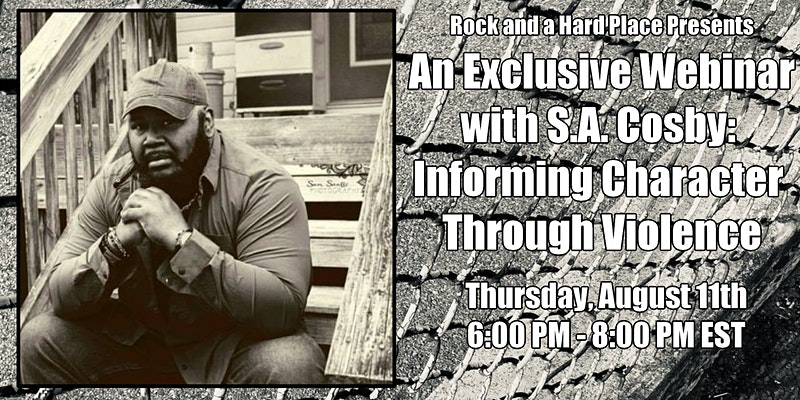Rock and a Hard Place Press sponsored a webinar with S A Cosby recently, and it was full of great information! If you get a chance to sit in on a panel, class, or webinar with Mr. Cosby, do it. Why?
Because Cosby:
- Is more well read in and out of the genre than many of my MFA classmates.
- Is generous with references and examples to illustrate each point. Your TBR pile will grow.
- Welcomes comments from attendees throughout the webinar, meaning we get to learn from everybody!
- Has genuine insight into the structure and elements of crime stories without being bound by tradition.
- Is funny, welcoming, and encouraging to all his fellow writers.

Here are the highlights I noted. Errors are mine.
Informing characters through violence
The title of Cosby’s talk intrigued me. I’ve used the threat of violence, violence off the page, or the aftermath of violence in my crime stories far more often than actual violence. Even when I do have a physically violent scene, it tends to be one beat as I don’t know how else to keep from killing my protagonist. Also, honestly, my life has been pretty easy and outbursts of violence have been limited. Coming of age in Las Vegas, which at that time was frequently violent or violence-adjacent, I learned just enough self-defense to create a window for running away. The one time a stranger was clearly sizing me up for an attack, my R-cortex took over and it had me bluff my way to safety. So what I don’t know about violence would fill a very large book…
I think of character and plot as two different views of the same thing. Thus, Cosby’s premise, that acts of violence on the page reveal character as much as they advance the plot, makes perfect sense. Here are some of the things I learned from attending the webinar.
Be true to your reader, your world, your character
Set boundaries–the limit on what your protagonist is willing to do, violence-wise, and stay consistent. If she’s challenged to go one step beyond, make sure the reader understands what’s at stake for her, and why she might be willing to go past her limits. And don’t forget the consequences.
Be sure you as the writer know why your character is committing violence, or allowing themselves to be pulled into a violent situation. And know how much your protagonist can realistically take (where “realistic” is a sliding scale, depending on genre, tone, and the world you’ve created. Jack Reacher’s “realistic” is quite different from Miss Marples).
At the end of a violent scene, the reader should understand how the plot has advanced, and how the character(s) may have changed (or we may have learned something new about them), setting up expectation and anticipation both. In other words, while the conflict of the scene may be resolved, the reader should be thinking both, “I KNOW something’s going to happen–but I’m not sure WHAT, exactly.”
Violent characters like Mouse in DEVIL IN A BLUE DRESS can function as metaphors as well as literal characters. Even so, they should have arcs and lives of their own. Avoid the Magical Bodyguard syndrome to keep readers engaged.
I’m quite in awe of the breadth and depth of Cosby’s reading, and hope to have a chance to apply what I learned in my WiP, set in Hilo, HI in the 1930s, a world well acquainted with all manner of violence.
Recommendation: sign up for any webinar or speaking event where Cosby is sharing his knowledge.
Now, I need to get back to Razorblade Tears…